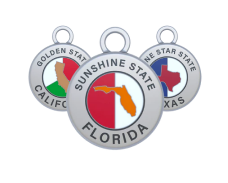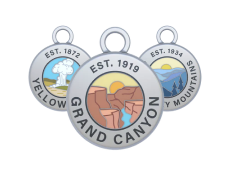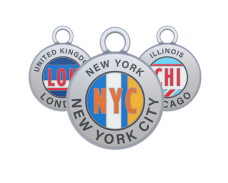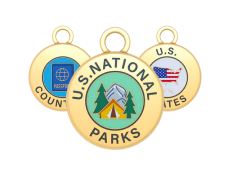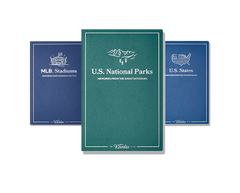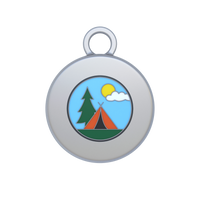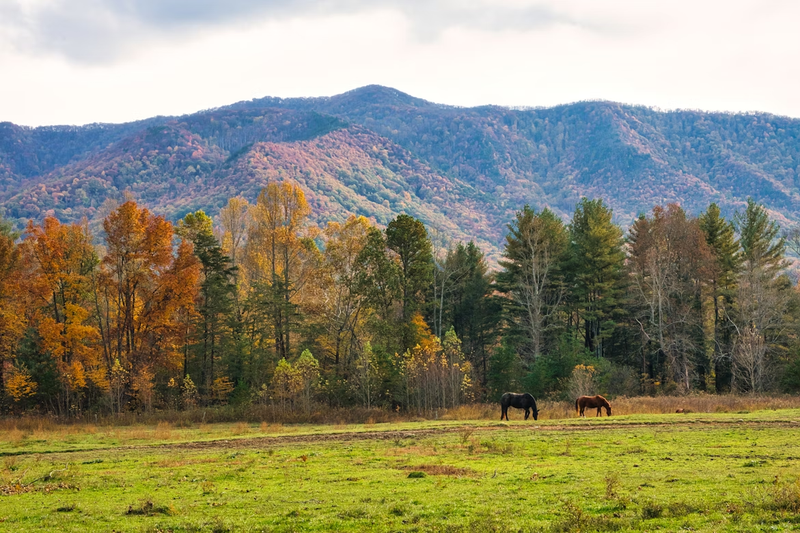
Key Takeaways:
- Explore Iconic Hikes, Waterfalls, & Scenic Routes: Discover the enchanting landscapes of the Great Smoky Mountains National Park through unforgettable hikes, mesmerizing waterfalls, and picturesque scenic drives.
- Plan Around The Seasons For The Best Experience: Experience the park's diverse regions and determine the best seasonal times to visit for extraordinary adventures and breathtaking natural beauty.
- Go Beyond The Basics With Local Flavor And Hidden Gems: Immerse yourself in local cuisine and uncover hidden trails and treasures for a truly memorable adventure in America's beloved wilderness.
The Great Smoky Mountains hold stories in every trail, waterfall, and quiet mountain road. Whether you’re drawn to high ridgelines, rushing streams, or peaceful valley drives, this national park delivers a rich mix of natural beauty and outdoor adventure.
At The Wander Club, we design meaningful keepsakes that help travelers remember where they’ve been and look forward to what’s next. With handcrafted tokens, durable holders, and thoughtful personalization, every piece tells a story.
In this blog, we’ll break down the top things to do in Great Smoky Mountains National Park, including iconic hikes and scenic drives to hidden waterfalls, seasonal tips, and ways to turn your adventure into a lasting memory.
Your Smokies At A Glance: Regions And Entry Points
Your journey through the Great Smoky Mountains National Park begins when you choose your starting point. Each region of the Smokies feels like its own chapter; a new landscape, a fresh possibility, another adventure for your travel collection.
The North Carolina Side
If you enter from the south, Cherokee greets you with a sense of history and tradition. Here, you can dive straight into Mingus Mill, the Oconaluftee Visitor Center, and sweeping views along Clingmans Dome Road. This area is known for wildlife sightings and access to quiet riverside hikes like Deep Creek, which is famous for its trio of easy-to-reach waterfalls.
The Tennessee Side
Coming in from the north, Gatlinburg or Townsend are your likely trailheads. Whether you crave the bustling energy of Gatlinburg, with quick access to Sugarlands Visitor Center and the ever-popular Laurel Falls Trail, or the tranquil, nature-centered approach through Townsend, you’ll find an entry point to match your vibe. Cades Cove, looped by an 11-mile scenic drive, offers gentle hiking, historic homesteads, and frequent bear encounters in spring and fall.
Newfound Gap Road
This iconic road links the Tennessee and North Carolina entrances. It’s your gateway to high-elevation views, Appalachian Trail sections, and epic overlooks like Morton Overlook. Pulling off for a quick photo or wind-in-your-hair moment adds another memory to your collection.
Less-Traveled Entrances
Bryson City offers easy river access perfect for tubing adventures, while Cosby is a low-key gateway to less crowded backcountry hikes and wildflower meadows. Cosby’s campground is a favorite for those who want a peaceful launching pad close to nature.
As you explore these different entry points and regions, it helps to have a way to track each place you've wandered through. Our National Park Tokens Bundle Booklet is an easy way to mark where you started, what you saw, and the path you made your own.
Best Activities In The Smoky Mountains: Hikes, Waterfalls & Scenic Drives
The Great Smoky Mountains National Park is practically overflowing with must-do experiences, each one inviting you to create your own story in this wild and wondrous place.
1. Lace Up And Hit The Trails
Step out on foot and see why hiking tops the list of great Smoky Mountains National Park things to do. The park is famous for its diversity of trails. Take the family-friendly Laurel Falls Trail, where a paved path leads you to a stunning, photogenic waterfall. Prefer something a little wilder? Venture onto Alum Cave Trail for dramatic bluffs and panoramic views, or tackle the climb up Mount LeConte, where the horizon stretches on forever.
2. Chase The Sound Of Waterfalls
The Smokies are home to over 100 named falls and cascades, each unique in beauty. Grotto Falls offers a magical walk behind a curtain of water, while Abrams Falls pairs a short hike with one of the park’s most powerful flows. For a hidden gem, search out Rainbow Falls after a rain shower, when the mist creates kaleidoscopic effects in the sunlight.
3. Roll Down The Windows And Go For A Drive
You don’t need hiking boots to experience the park’s awe-inspiring vistas. Scenic drives are one of the top great Smoky Mountains National Park things to do for all ages. Cruise along Newfound Gap Road, which cuts straight through the mountains, connecting Tennessee and North Carolina with sweeping overlooks at every turn. Cades Cove Loop is a crowd favorite, especially when deer and wild turkeys step shyly into meadows at sunrise or sunset. The Roaring Fork Motor Nature Trail delivers dense forest, rushing streams, and remnants of pioneer cabins, all without leaving the comfort of your car.
Whether you hike a trail, find a quiet waterfall, or just pull over at the perfect overlook, each stop can be remembered in a small but meaningful way. Many visitors collect our U.S. National Park Tokens to capture those exact places. Over time, these simple markers build into a personal record of the wild moments that mattered most.
Seasonal Secrets: Best Times To Visit The Smokies
Timing is everything when planning your Great Smoky Mountains National Park bucket list. Every season reveals a different side of this iconic landscape.
- Spring: Wildflowers & Waterfalls: Spring brings blooming trails like Porter’s Creek and Schoolhouse Gap, plus waterfalls at peak flow from rain and snowmelt. Expect cool mornings and warm afternoons; layers are essential for shifting temperatures throughout the day.
- Summer: Green Peaks & Long Days: The forest turns lush and vibrant. Escape the heat at higher elevations like Clingmans Dome. Early hikes reveal misty views, and extended daylight offers more time for swimming, hiking, and scenic drives. Weekends get crowded, so go early or explore quieter trails.
- Fall: Peak Foliage & Scenic Drives: From early to late October, fall delivers vibrant foliage. Popular spots like Cades Cove light up with color but also draw large crowds. Plan for sunrise hikes or weekday visits to enjoy fall beauty without the congestion.
- Winter: Quiet Trails & Frosted Views: Winter reveals stillness and snow-dusted scenery. Trails like Alum Cave offer peaceful hikes and icy views. Fewer visitors and open landscapes make this an excellent time for solitude. Watch for weather-related road closures and enjoy the park’s quiet charm.
Local Eats And Treats To Refuel Between Adventures
The towns bordering Great Smoky Mountains National Park brim with delicious, down-to-earth dining and classic Southern treats that satisfy every trail-laden appetite.
Hearty Southern Fare In Gatlinburg
After a day on the trails, Gatlinburg offers plenty of satisfying options. Stop at a local smokehouse for slow-cooked barbecue, cornbread, or pulled pork. For something lighter, small cafés serve up biscuits with fresh eggs and seasonal jam from nearby farms.
Classic Sweets And Sips In Pigeon Forge
Refuel with old-school candy, hand-pulled taffy, or a local ice cream shop scoop. Fudge made in-house is a favorite takeaway treat. To wind down your day, refresh with orchard-fresh apple cider or sample a glass of locally made moonshine.
Small-Town Comfort Food And Local Markets
In Townsend and nearby hamlets, diners serve homestyle breakfasts, fried green tomatoes, and community-favorite meals. Farm markets offer ripe peaches and fresh produce, while roadside stands are stocked with pies, honey, and baked goods perfect for trail snacks or post-hike rewards.
What To Pack For A Smoky Mountains Adventure
Packing right means you’ll be able to chase thundering waterfalls on a misty morning, pause on wildflower-strewn footpaths, and still have energy for a sunset drive along those scenic ridges.
Here’s how to make sure you’re well-equipped for every unforgettable moment:
- Layer Up: The Smokies' weather is delightfully unpredictable, morning fog, midday sun, a passing shower. Bring moisture-wicking base layers, a cozy fleece or lightweight jacket, and a rain shell that’s easy to stuff in your daypack. If you’re out after sunset, a beanie and gloves can make a world of difference.
- Trail-Ready Footwear: Comfort is your currency on rocky and root-strewn hikes. Go for broken-in, supportive hiking boots or sturdy trail shoes. Even easy waterfall walks can get slippery, so don’t forget extra socks for the inevitable splash zone.
- Hydration Gear: Refillable water bottles or a hydration bladder will keep you fueled and eco-friendly as you climb those switchbacks or cruise from overlook to overlook. Pack a snack or two – think protein bars or trail mix – so you have energy to keep exploring.
- Navigation & Safety Essentials: A good map or GPS app is invaluable, even with well-marked trails. Add a compact first aid kit, sunscreen, and insect repellent – being overprepared is better than being sidelined by a sunburn or bug bite.
- Camera Or Binoculars: The Smoky Mountains are a photographer’s wonderland. Whether you’re aiming to catch that signature blue haze or spot a black bear in Cades Cove, you’ll want a way to zoom in on those once-in-a-lifetime scenes.
- Personal Touches: Leave a little room for the gear or memorabilia that will help you cherish your adventure long after the mountain mist clears. A journal, a sketchpad, or your favorite pocket-sized keepsake turns each stop into a lasting memory.
Final Thoughts
Your adventures in the Great Smoky Mountains National Park are about connection. At The Wander Club, we believe in collecting these moments as meaningful tokens that mark your journey and reflect your stewardship for the places you love.
As you explore the best things to do in the great Smoky Mountains National Park, carry a piece of your journey with you. When you collect and share your stories, you inspire others to get outside and support our national treasures.
So keep exploring, keep collecting your travels, and together let’s make every journey a force for good.
Read also:
- 8 Travel Photography Tips for Beginners
- 12 Van Life Must Haves for a Smooth Road Trip
- Best Travel Gifts for Her: 30+ Suggestions
Frequently Asked Questions About Great Smoky Mountains National Park Things To Do
What is the best time of year to visit the Smoky Mountains?
Spring brings wildflowers and rushing waterfalls – a treat for hikers and photographers. Summer delivers lush, green views and comfortable temps at higher elevations. Autumn is famous for fiery foliage, so if you love a scenic drive, this is your golden hour. Winter is quieter and magical with the proper dusting of snow; some trails offer solitude and new perspectives.
Are there entrance fees for the park?
You’ll be happy that the Great Smoky Mountains National Park doesn’t charge an entrance fee. However, there is a modest parking tag requirement if you plan to leave your car for over 15 minutes. These tags help protect the park’s beauty for generations and can be purchased online or at visitor centers.
What are the top-rated hikes in the Smoky Mountains?
Alum Cave Trail to Mount LeConte is a fan favorite, rewarding you with stunning vistas and geological marvels. Clingmans Dome is a must for panoramic views; it’s a steep, paved walk suitable for families. If you want waterfalls, Laurel Falls and Rainbow Falls pack epic scenery into manageable hikes. For a peaceful meander, the Oconaluftee River Trail offers an easy, accessible route rich with history.
How can I find waterfalls in the Smoky Mountains?
Waterfalls are scattered throughout the park like hidden treasures. Start with well-loved trails such as Laurel Falls, Grotto Falls, and Abrams Falls. Visit the Sugarlands or Oconaluftee Visitor Center for trail maps, ranger advice, and current trail conditions. Apps and guides are also helpful if you want to chase more secluded cascades. Don’t forget your camera—and a token to remember each waterfall adventure!
Are there scenic drives suitable for families?
Absolutely. Cades Cove Loop is a classic: an 11-mile, one-way route where you’ll spot wildlife, old cabins, and endless mountain views – plus plenty of places to pull off for a stretch or a picnic. Newfound Gap Road delivers scenic overlooks and easy access to hiking trails. Little River Road connects Gatlinburg to Cades Cove, offering river views and easy stops at places like Sinks or Meigs Falls. Load some snacks and hit the road; these routes are made for making memories together.
What wildlife might I encounter during my visit?
You’re likely to glimpse white-tailed deer, wild turkeys, and (with a little luck), black bears roaming the meadows and forested slopes. Elk have made an exciting comeback in the Cataloochee Valley. Keep your distance, respect their space, and enjoy wildlife from afar – binoculars are handy! Birdwatchers will love spotting warblers, woodpeckers, and hawks.
Are pets allowed on trails and scenic drives?
Pets are welcome in developed areas and campgrounds, but they’re only allowed on two short walking paths: the Gatlinburg Trail and the Oconaluftee River Trail. For their safety and to protect local wildlife, please use a leash and never leave pets unattended. You can bring them along on scenic drives, but always ensure they’re comfortable and safe in your vehicle.
What safety tips should I follow while hiking?
Stay on marked trails and pack more water than you think you’ll need—hydration is your best hiking buddy. Check local weather conditions before you head out, and let someone know your itinerary. Be bear aware: carry a bear bell or spray, make noise while hiking, and store food securely. Leave only footprints behind and take all trash out with you. Consider adding a Great Smoky Mountains token from The Wander Club to your collection to celebrate safe and meaningful journeys.



